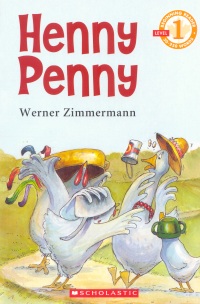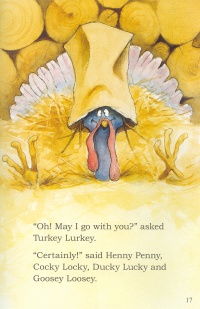| ________________
CM . . .
. Volume XX Number 20. . . .January 24, 2014
excerpt:
H. Werner Zimmermann first published his version of the classic folk tale, Henny Penny in 1989. His interpretation includes colourful characters proceeding through the tale to tell the King the sky is falling. There are several conclusions of the trek of barnyard animals and their encounter with the fox through literature. This version reports sadly that they were never seen again.
Scholastic has presented this as an easy reader within their First, Beginning, Developing and Growing Reader levels. This particular choice is considered a Level 1 Beginning Reader. The characteristics of this level include 50-250 word count, sight words, decodable words and simple sentences. The actual text count of this book is 429. Further guidance on the back cover indicates this is at Pre-K-1 grade level, a Guided Reading Level of I (which is considered late grade one range in leveled text) and a Lexile® Level of AD610L. The Lexile® Level is derived from the Lexile® Framework for Reading. It is a computerized approach to obtain a Lexile® Reading Measure of a reader’s ability on the Lexile®scale. The text is also measured for assignment on the Lexile®scale. Subsequently, this allows the reader to choose their text match for ease in comprehension. There are a few tests that measure for Lexile® scores with Scholastic Reading Inventory being one. Students would enjoy the illustrations and reading the growing list of characters on their way to find the King. The chosen ending, however, may give the teacher a moment to ponder whether the text is one they would use, given the young age of the reader and the not-so-pleasant conclusion inferred for these comical characters. The Lexile®designation also indicates the text may be at the higher end of the text difficulty range expected for this reading instructional range. The use of quality children’s literature in reading instruction is always appreciated. This text provides many visual cues and the repetition of the language is enjoyed by readers of this age. Recommended with Reservations. Susan Barnabe is a Certified Reading Clinician who lives in Winnipeg, MB.
To comment
on this title or this review, send mail to cm@umanitoba.ca.
Copyright © the Manitoba Library Association. Reproduction for personal
use is permitted only if this copyright notice is maintained. Any
other reproduction is prohibited without permission.
NEXT REVIEW |
TABLE OF CONTENTS FOR THIS ISSUE
- January 24, 2014.
AUTHORS |
TITLES |
MEDIA REVIEWS |
PROFILES |
BACK ISSUES |
SEARCH |
CMARCHIVE |
HOME |

 This copy published by Scholastic is nearly identical to the1989 version with a minor picture change on the cover. The text remains the same although the placement of thought units within the sentence is changed on a few pages. Either by the demand of text size or ease of reading for the young reader, it is effective and does not change the quality of the read.
This copy published by Scholastic is nearly identical to the1989 version with a minor picture change on the cover. The text remains the same although the placement of thought units within the sentence is changed on a few pages. Either by the demand of text size or ease of reading for the young reader, it is effective and does not change the quality of the read.